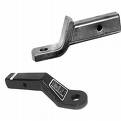Select Proper Capacity Components
Having the proper vehicle or the properly equipped vehicle for four-down towing is not all you need. First, you need to be sure that the GVCWR of your motorhome (the weight of your motorhome and the weight of your toad) does not exceed the maximum value specified by the RV manufacturer. Recently, I have noticed that many of the newer motorhomes that have a GVWR of 22,000 lbs. still have a GCWR of only 26,000 lbs.—meaning that your toad cannot weigh more than 4,000 lbs. (severely limiting your choice of a toad)—unless you reduce the weight of what you are carrying in the motorhome.
Next, you need to be sure that the hitch capacity of your motorhome is sufficient to pull the weight of your toad. Most older motorhomes have a hitch capacity of 3,500 lbs., whereas most newer motorhomes have a hitch capacity of 5,000 lbs. (For example, my Dodge Dakota pickup weighs about 4,500 pounds, and cannot safely be towed by a motorhome that only has a 3,500 lb. hitch capacity.)
One very important item in your selection process is the base plate that you select for your vehicle. A base plate is a bunch of welded steel, engineered specifically for your particular vehicle, and is bolted to the frame of your vehicle. The tow bar attaches to the base plate to tow your vehicle.
Like almost everything else, there are different styles of base plates. Some base plates are always visible, some having a steel bar in front of the bumper. Other base plates have arms that plug into the base plate (with small receiver-like attachments), and then the cross bar attaches to the arms. With this style of base plate, it is almost , but not quite, invisible—the small receivers on the base plate being hidden in or under the grill of the vehicle. There are a couple of prominent vendors of base plates and tow bars—but you must be aware that the parts are not interchangeable. If you purchase one vendor’s base plate, then you need to get that same vendor’s tow bar.
The next item on the checklist is to be sure that the tow bar you select can also pull the required load. Most tow bars are rated at 5,000 lbs.—but be sure you know before you buy
There are three types of tow bars generally used for towing a toad:
- A fixed V-bar type that does not fold flat against the bumper, but sticks up in the air (looking like an inverted V when it is not connected to the motorhome.
- A foldable (or collapsible) tow bar that usually remains attached to the toad, but can be folded almost flat against the toad bumper. (These tow bars have a 2-inch ball cup and require that the motorhome have a 2-inch ball.)
- A foldable (collapsible) tow bar that stays attached to the motorhome and folds "sort of flat" near the rear bumper. These tow bars are equipped with a 2” draw bar that fits into the receiver on the motorhome. If you have an older motorhome and want to use one of these tow bars, first be sure that the motorhome has a 2-inch receiver tube.
Remember, if you have a vehicle that weighs more than 3,500 lbs., you need a 5,000 lb. hitch ball (one with a 1-inch diameter shank—and not a ¾” shank, which is good for only 3,500 lbs.)
Unless you choose a foldable tow bar that stays on your motorhome, there are some additional items that you need. For either the fixed tow bar or the foldable tow bar that remains on the toad, you will also need to outfit the motorhome with the proper sized draw bar and hitch ball. The draw bar is a square length of metal that slides into the receiver on the motorhome and is secured with a hitch pin and a clasp or a locking hitch pin. Again, be sure that the draw bar you select is also rated for the load of the toad—a draw bar rated for 3,500 lbs. will have only a ¾” hole in it, whereas the 5,000 lb. rated draw bar will have a 1-inch hole in it for the ball.
But, before you buy that draw bar, you need to have done a little homework. You need to know the height of your motorhome’s receiver from the ground, and you also need to know the height of your tow bar where it pivots on the tow bar mounts on the toad (usually somewhere near the center of the bumper).
Some draw bars are straight (with the hitch ball at almost the same height as the receiver in the motorhome), and some draw bars have either a drop or a rise (placing the ball at a height that is either lower or higher than the receiver on the motorhome)—depending on whether you place the ball on the top or the bottom of the draw bar.
 |
|
 |
You need to select a draw bar that will have the tow bar almost flat (level) between the toad and the motorhome. Most draw bars have a small decal on them, telling you how much rise or drop is provided by that particular bar. You will have to settle for “a little bit off” in either direction, but be sure that the tow bar sits either level or slightly uphill—do not get a draw bar that will have the tow bar sloping down from the toad to the motorhome. The "slightly uphill" arrangement puts less strain on the tow bar and also lets gravity help a wee bit if the ball should ever come loose or the tow bar comes loose from the ball.

